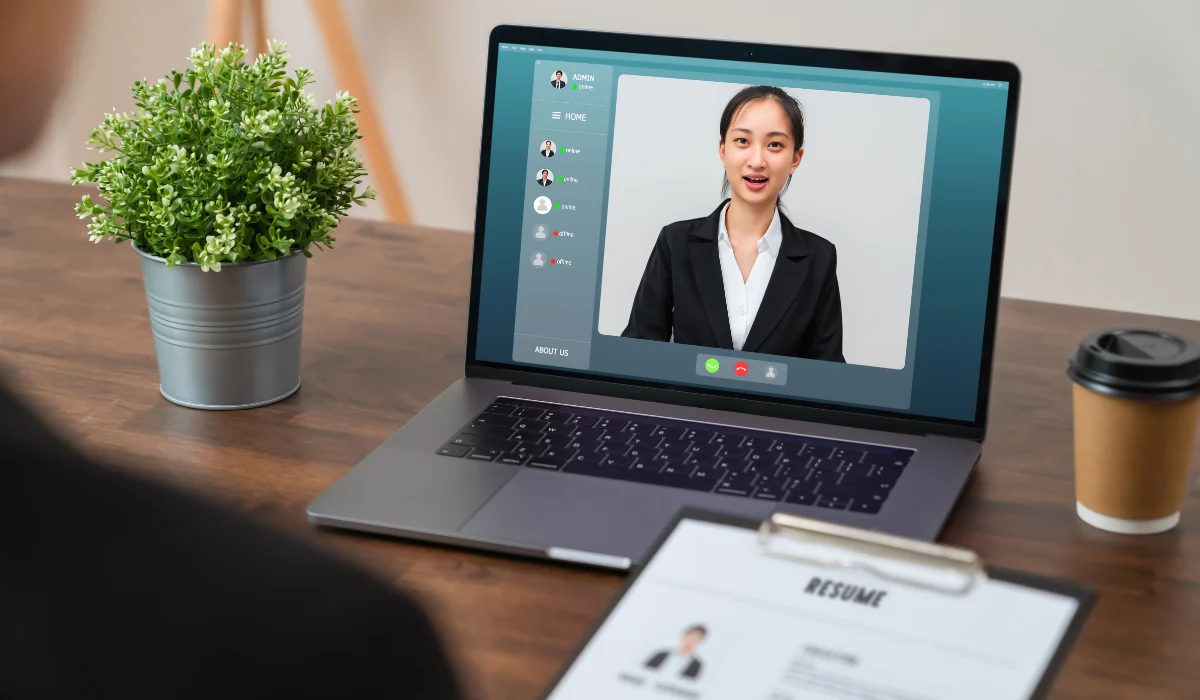
How Can You Reduce Bias in One-Way Video Interviews?
Oct 23, 2025 |
One-way video interviews, also called asynchronous interviews, have changed how companies hire people. Instead of scheduling live interviews, candidates record their answers to pre-set questions whenever it suits them, and recruiters watch these recordings later. This approach saves time and makes hiring easier, but there's a challenge we need to address: how do we reduce bias in one-way video interviews to make sure every candidate gets a fair chance?
More companies are using one-way video interview software these days, which makes tackling bias more important than ever. Whilst this interview style can remove some traditional biases like favouring people who interview well in person or those with flexible schedules it needs careful planning to stay truly fair. This guide shares practical tips to help you build a fairer hiring process through bias-free video interviewing.
TL;DR
- One-way video interviews naturally eliminate many traditional hiring biases, like scheduling advantages and in-person presentation effects.
- Use structured question sets and standardised response times for all candidates to ensure consistency.
- Choose platforms with bias-reduction features: randomised questions, built-in scoring rubrics, and mobile compatibility.
- Craft competency-based questions using inclusive language that avoids cultural references and jargon.
- Implement standardised scoring rubrics with clear criteria before reviewing any responses.
- Regularly monitor patterns, collect candidate feedback, and refine your process based on data.
- When appropriately designed, asynchronous interviews offer powerful advantages for fair, effective hiring.
Recognising Bias: What Recruiters Need to Know
Before fixing bias, you need to understand what it looks like. Bias in hiring comes in two main types: Unconscious bias and Conscious bias.
Common biases in video interviews include favouring certain genders, judging people by their age, making assumptions based on cultural background, reacting negatively to accents or language differences, and drawing conclusions from someone's education or economic background. Even things like how tidy someone's home looks in the background or what they're wearing can unfairly influence your opinion.
One-way video interviews naturally reduce some biases. For example, they remove the instant connection that might make you favour outgoing candidates or people who remind you of yourself. When designed with fairness in mind from the start, these interviews help evaluators focus on the substance of what candidates actually say rather than surface-level presentation factors.
How to Design Bias-Free Video Interviews
The beauty of one-way video interviews lies in their flexibility and fairness when designed thoughtfully. Asynchronous interview fairness starts with smart system design that gives every candidate an equal opportunity to shine. Here's how to set things up for success:
1. Structured Interview Format
One-way interviews excel at consistency. Every candidate encounters exactly the same questions in the same format, which means you're comparing everyone on equal footing. Create a standard set of questions aligned with specific job competencies, and maintain this consistency across all candidates. This structured approach is one of the format's greatest strengths.
2. Standardised Process
Set the same rules for everyone. Give all candidates the same amount of time to think (usually 2-3 minutes) and respond (typically 2-5 minutes). Make sure everyone gets identical instructions, both written and in video format. This consistency means no one gets an unfair advantage from extra help or clearer directions.
3. Recruiter-Friendly Software Features
Good one-way video interview software should actively help you hire fairly. At ScreeningHive, we've built features specifically to support bias-free interviewing because we believe technology should actively promote fair hiring, not just automate processes. Look for platforms that offer:
- Mixed-up question order: This stops later candidates from gaining advantages if earlier ones share the questions.
- Easy-to-use interface: Complicated systems disadvantage people who aren't tech-savvy.
- Consistent recording quality: Make sure all videos look and sound similar when you review them.
- Built-in scoring templates: Pre-made rating systems help you stay objective.
4. Technical Reliability
Technical problems hurt candidates who don't have great internet or new devices. Choose platforms that provide:
- Stable performance that adapts to varying internet speeds.
- Automatic notifications for any submission issues, allowing quick resubmission.
- Full compatibility across mobile devices, tablets, and computers, giving candidates true flexibility.
- Responsive technical support during interview windows.
Writing Questions That Keep Bias Out of Your Interviews
The questions you ask make a huge difference to fairness. Well-written questions help you focus on job skills rather than surface-level impressions.
1. Behavioural and Competency-Based Questions
Ask about real past experiences. Instead of "How would you handle conflict?" try "Tell me about a time when you disagreed with a colleague. What happened, what did you do, and how did it turn out?" This approach lets you judge people on actual examples rather than how well they talk or present themselves.
2. Inclusive Language
Avoid phrases or references that might confuse people from different backgrounds. Instead of "How do you handle curveballs?" ask "How do you manage unexpected challenges?" Use gender-neutral words throughout. Don't ask about "gaps" in work history without recognising that people take breaks for many valid reasons that affect different groups differently.
3. Balanced Difficulty
Don't assume everyone has the same education or knows industry jargon. If technical knowledge is truly needed for the job, say so clearly and explain the terms. Avoid questions about specific hobbies or social activities that might exclude people from different backgrounds.
How to Score and Evaluate Candidates Objectively
Even perfect interviews fail if you don't review them properly. Here's how to stay objective:
1. Standardised Scoring Rubrics
Create detailed rating guides before watching any videos. Define what "excellent," "good," and "needs work" actually mean for each skill. For example, when judging problem-solving, be specific: excellent answers should identify the real problem, consider different solutions, explain why they chose their approach, and reflect on what happened.
2. Blind Evaluation (Where Possible)
Some advanced platforms can show you written transcripts before you watch the videos. This removes visual biases. If that's not possible, train your team to write notes only about what candidates say, not how they look, where they're recording from, or how they speak (unless speaking skills are genuinely required for the role).
3. Evaluator Training and Practice Sessions
Have multiple recruiters score the same practice videos, then compare your ratings. If you're rating people very differently, it means you're not using the same standards. Regular discussion sessions where you talk through why you scored things certain ways help everyone stay aligned and spot hidden biases.
Best Practices to Continuously Reduce Bias
Reducing bias isn't something you do once and forget about. It's an ongoing commitment.
- Regular Review: Every few months, look at which questions create the most different scores and whether certain groups consistently score higher or lower. Unexplained patterns might mean there's a problem with your questions or how you're scoring them.
- Candidate Feedback: Ask candidates anonymously about their experience. Simple questions like "Did this interview let you show your real abilities?" give you valuable insights. If you notice patterns of negative feedback from specific groups, investigate why.
- Document and Monitor: Keep detailed records of your interview process, including why you chose certain questions, how you define ratings, and when you trained your team. Track hiring results across different demographic groups. Clear documentation helps you spot bias and shows you're serious about inclusive hiring practices.
- Balance Structure with Judgement: Whilst standardisation reduces bias, leave room for thoughtful human judgement. Not every great candidate presents themselves the same way. Structured processes should guide your decisions, not replace careful consideration of each person's unique strengths.
Conclusion
One-way video interviews offer powerful advantages for fair hiring: consistency, flexibility for candidates, and the ability to evaluate thoughtfully without time pressure. When you combine these inherent strengths with smart system design, well-crafted questions, and objective evaluation, you create a hiring process that's both efficient and equitable.
ScreeningHive is built around these principles, offering features designed to support inclusive hiring whilst giving candidates the flexibility to present their best selves.
Ready to build a fairer hiring process? Start implementing these strategies today and experience how structured, asynchronous interviews can transform your recruitment outcomes.
FAQs (Frequently Asked Questions)
1. What is bias in one-way video interviews?
Bias in one-way video interviews refers to any unfair advantage or disadvantage given to a candidate based on factors unrelated to their skills, experience, or fit for the role, such as appearance, accent, or background.
2. Why is reducing bias in one-way video interviews important?
Reducing bias ensures fair evaluation, improves candidate experience, promotes diversity and inclusion, and helps recruiters make better, merit-based hiring decisions.
3. Can technology help reduce bias in one-way video interviews?
Yes. Platforms with features like structured question templates, standardised scoring, and randomised question order can help reduce bias and ensure fairness.
4. How can recruiters reduce bias in one-way video interviews?
Recruiters can reduce bias by using structured interview design, crafting fair, competency-based questions, implementing standardised scoring rubrics, and Training evaluators for objective assessments.
5. How often should recruiters review their one-way interview process for bias?
Regularly, ideally every few months or after major hiring cycles. Reviewing questions, scoring trends, and candidate feedback helps identify and mitigate bias.







